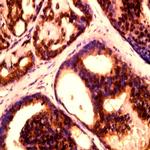Search Thermo Fisher Scientific
FIGURE: 1 / 1
Phospho-L1CAM (Ser1152) Antibody (630-210) in IHC (P)

Product Details
630-210
Species Reactivity
Host/Isotype
Class
Type
Immunogen
Conjugate
Form
Concentration
Purification
Storage buffer
Contains
Storage conditions
Shipping conditions
Product Specific Information
Positive control: Human kidney
Cellular location: Cell membrane.
Target Information
L1CAM/CD171 is an axonal glycoprotein belonging to the immunoglobulin supergene family. The ectodomain, consisting of several immunoglobulin-like domains and fibronectin-like repeats (type III), is linked via a single transmembrane sequence to a conserved cytoplasmic domain. This cell adhesion molecule plays an important role in nervous system development, including neuronal migration and differentiation. Mutations in the gene cause three X-linked neurological syndromes known by the acronym CRASH (corpus callosum hypoplasia, retardation, aphasia, spastic paraplegia and hydrocephalus). Alternative splicing of a neuron-specific exon is thought to be functionally relevant.
For Research Use Only. Not for use in diagnostic procedures. Not for resale without express authorization.
References (0)
Bioinformatics
Protein Aliases: antigen identified by monoclonal antibody R1; CD 171; CD171; CD171 molecule; N-CAM L1; N-CAM-L1; NCAM-L1; Nerve-growth factor-inducible large external glycoprotein; Neural cell adhesion molecule L1; neuron-glia cell adhesion molecule (Ng-CAM); Neuronal-glial cell adhesion molecule; Ng-CAM; NILE; sCD171; sL1 CAM; sL1CAM; soluble CD 171; soluble CD171; soluble L1 CAM; soluble L1CAM
Gene Aliases: CAML1; CD171; HSAS; HSAS1; Hyd; L1; L1CAM; MASA; MIC5; N-CAM-L1; N-CAML1; NCAM-L1; NCAML1; S10; SPG1
UniProt ID: (Human) P32004, (Chicken) Q03696, (Rat) Q05695
Entrez Gene ID: (Human) 3897, (Chicken) 396059, (Dog) 492244, (Bovine) 516017, (Mouse) 16728, (Rat) 50687

Performance Guarantee
If an Invitrogen™ antibody doesn't perform as described on our website or datasheet,we'll replace the product at no cost to you, or provide you with a credit for a future purchase.*
Learn more
We're here to help
Get expert recommendations for common problems or connect directly with an on staff expert for technical assistance related to applications, equipment and general product use.
Contact tech support
